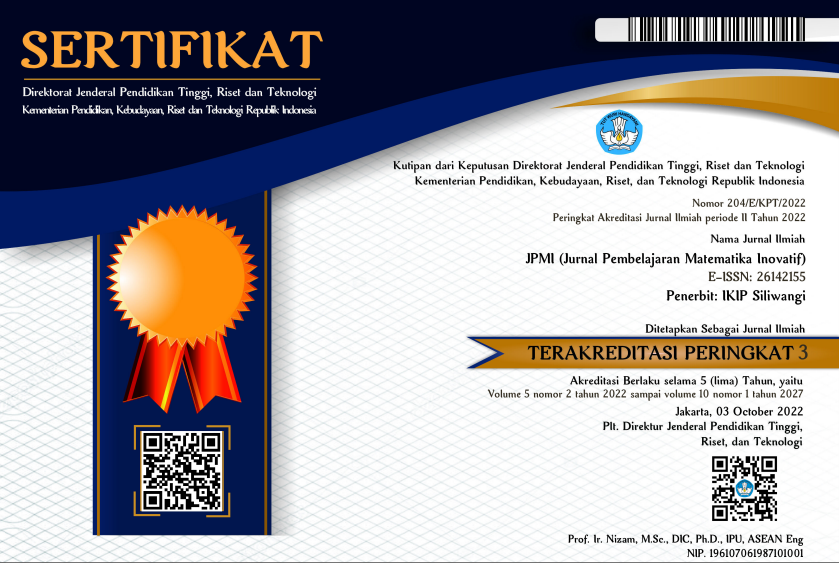ANALISIS VIDEO PEMBELAJARAN MATEMATIKA MAHASISWA PGSD UNIVERSITAS MATARAM PADA MATA KULIAH PEMBELAJARAN MATEMATIKA SD
DOI:
https://doi.org/10.22460/jpmi.v3i6.p%25pKeywords:
Video Analysis, Learning Stages, Primary Mathematics LearningAbstract
This qualitative research aims to analyze the stages of mathematics learning activities carried out by primary school teacher candidates at the University of Mataram. The data analysis of this research was conducted in a descriptive qualitative manner. The research subjects were randomly selected consisting of two primary school teacher candidates who have different genders but have the same academic ability. The data analysis process was carried out by collecting data, presenting data, and drawing conclusions. Data collection was obtained through instructional videos of primary school teacher candidates in primary school mathematics learning courses . The presentation of data is done by describing the stages of learning activities that the teacher must do in the classroom. The results of this study indicate that the research subjects have their respective strengths and weaknesses in the implementation of learning activities, the material abilities of the research subjects are still weak in learning activities and the research subjects do not utilize/use knowledge in previous courses to improve teaching quality.References
Bogdan, R. C., & Biklen, S. K. (2007). Qualitative research for education: an introduction to theories and methods (5th ed.). Boston: Pearson Education, Inc.
Chizhik, E. W., & Chizhik, A. W. (2018). Using Activity Theory to Examine How Teachers’ Lesson Plans Meet Students’ Learning Needs. Teacher Educator, 53(1), 67–85. https://doi.org/10.1080/08878730.2017.1296913
Coorey, J. (2016). Active Learning Methods and Technology: Strategies for Design Education. International Journal of Art and Design Education, 35(3), 337–347. https://doi.org/10.1111/jade.12112
Cowan, P. (2006). Teaching mathematics. New York: Routledge.
Gifford, S. (2005). Teaching Mathematics 3-5: Developing Learning in the Foundation Stage. New York: Open University Press.
Hannover, B., & Kessels, U. (2004). Self-to-prototype matching as a strategy for making academic choices. Why high school students do not like math and science. Learning and Instruction, 14(1), 51–67. https://doi.org/10.1016/j.learninstruc.2003.10.002
Iurmanova, S. A., & Balykhina, T. M. (2017). Scientific research activity: the origin of teaching methodology. Russian Linguistic Bulletin, 4(4), 40–41. https://doi.org/10.18454/RULB.4.12
Krantz, S. G. (2015). How to Teach Mathematics. In The American Mathematical Monthly (Vol. 101). https://doi.org/10.2307/2974708
Kwakman, K. (2003). Factors affecting teachers’ participation in professional learning activities. Teaching and Teacher Education, 19(2), 149–170. https://doi.org/10.1016/S0742-051X(02)00101-4
Leithwood, K., & Mascall, B. (2008). Collective leadership effects on student achievement. Educational Administration Quarterly, 44(4), 529–561. https://doi.org/10.1177/0013161X08321221
Montecinos, C., & Nielsen, L. E. (2004). Male Elementary Preservice Teachers’ Gendering of Teaching. Multicultural Perspectives, 6(2), 3–9. https://doi.org/10.1207/s15327892mcp0602_2
Pyhalto, K., Pietarinen, J., & Soini, T. (2015). Teachers professional agency and learning-from adaption to active modification in the teacher community. Teachers and Teaching: Theory and Practice, 21(7), 811–830. https://doi.org/10.1080/13540602.2014.995483
Seidel, T. (2006). The role of student characteristics in studying micro teaching-learning environments. Learning Environments Research, 9(3), 253–271. https://doi.org/10.1007/s10984-006-9012-x
Shemwell, J. T., Chase, C. C., & Schwartz, D. L. (2015). Seeking the general explanation: A test of inductive activities for learning and transfer. Journal of Research in Science Teaching, 52(1), 58–83. https://doi.org/10.1002/tea.21185
Szelei, N., Tinoca, L., & Pinho, A. S. (2019). Rethinking ‘cultural activities’: An examination of how teachers utilised student voice as a pedagogical tool in multicultural schools. Teaching and Teacher Education, 79, 176–187. https://doi.org/10.1016/j.tate.2018.12.020
Wright, M. C., Bergom, I., & Bartholomew, T. (2019). Decreased class size, increased active learning? Intended and enacted teaching strategies in smaller classes. Active Learning in Higher Education, 20(1), 51–62. https://doi.org/10.1177/1469787417735607

















